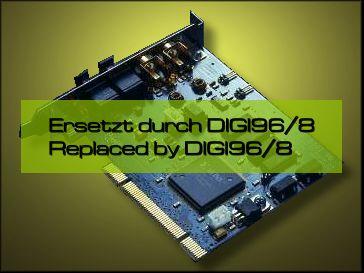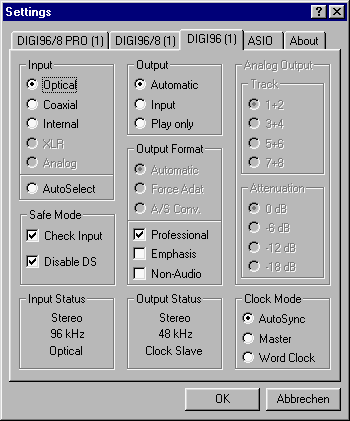 |
|

24 Bit/96 kHz SPDIF - AES/EBU PCI Digital
Audio Card |
|

|
 In
a short time the DIGI32 series has become the leader in the field of
digital I/O cards for PCI bus, thanks to its unsurpassed reliability, absolute
data integrity, minimum system load, rock solid drivers and tremendous performance.
Now RME proudly presents DIGI96®,
the more powerful DIGI32, adding numerous new features and capabilities like
Master mode, Enhanced Full Duplex, Zero Latency Monitoring, DIGICheck, AutoSelect,
96 kHz and Non-Audio (AC-3) channel status. In
a short time the DIGI32 series has become the leader in the field of
digital I/O cards for PCI bus, thanks to its unsurpassed reliability, absolute
data integrity, minimum system load, rock solid drivers and tremendous performance.
Now RME proudly presents DIGI96®,
the more powerful DIGI32, adding numerous new features and capabilities like
Master mode, Enhanced Full Duplex, Zero Latency Monitoring, DIGICheck, AutoSelect,
96 kHz and Non-Audio (AC-3) channel status.
DIGI96 is the result of an intensive development by hardware and software
cracks. Like its predecessor it will need only a short time to become the
new reference for digital audio PCI bus interfaces, for home and professional
use.
The DIGI96 offers drivers for Windows
95/98 (MME, DirectSound, ASIO 2.0, GSIF), Windows NT (MME, ASIO
2.0), Windows 2000/XP (MME, ASIO 2.0, GSIF), MacOS
(Sound Manager and ASIO 2.0) and Linux
(OSS and ALSA.)
DIGI96 comes with an incredible free
utility: DIGICheck,
the ultimate measurement, analysis and test tool!
|

|
 Just
click on the DIGI symbol in the systray of the taskbar and the settings dialog
of the DIGI96 comes up. The clear structured, easy to understand window
plus the unique informative status displays for input and output make your
work with the DIGI96 to a real pleasure. With a simple mouse click
(or a freely configurable key shortcut) you gain access to the full power
of your card. Just
click on the DIGI symbol in the systray of the taskbar and the settings dialog
of the DIGI96 comes up. The clear structured, easy to understand window
plus the unique informative status displays for input and output make your
work with the DIGI96 to a real pleasure. With a simple mouse click
(or a freely configurable key shortcut) you gain access to the full power
of your card.
RME's Settings dialog shows installed and active DIGI96®
series' cards, according to their numbering in the system. Therefore even
in multicard usage you'll always know which wave device belongs to which card.
The latest drivers can be found on our Download
page. |
| |

|
| Supported sample frequencies: 32 kHz, 44.1 kHz, 48 kHz, 64 kHz, 88.2
kHz, 96 kHz |
| All settings changeable in real-time, all output options even in playback
mode |
| Separate record- and playback circuits; complete master mode |
| Enhanced
Full Duplex: Different sample rates at input and output possible |
| AutoSync:
Automatic and intelligent master/slave clock control |
| Outstanding PLL allows synchronization even at double/half sample rates |
| Optional Word
Clock Module (WCM) provides word clock input and output |
| TMS
(Track Marker Support): Supports CD/DAT Start-IDs and the read out of CD
subcode |
| Comes with
DIGICheck: the ultimate measurement, analysis and test tool |
| Unique status windows for record and playback, showing mode and sample
rate |
| Zero
Latency Monitoring: Hardware bypass per track, controlled by Punch-in/out |
| AutoSelect
searches automatically for an input with valid signal |
| Complete interrupt-sharing under Windows 95/98 and NT |
| Windows driver with Pentium® Pro/II/Celeron® optimization (quad times
memory transfer) |
| High bus transfer rate (up to 130 MByte/s) |
| Digital inputs and outputs ground-free transformer coupled |
| Super low jitter design: < 1 ns in PLL mode (44.1 kHz, optical in) |
| 32 bit memory transfer and 128 kB fast SRAM guarantee very low system
load |
| Digital I/O: optical (TOSLINK), coaxial (Cinch), internal (CD-ROM/Sync-I/O) |
| Formats: SPDIF - AES/EBU (Consumer, Professional) |
These are only some
of DIGI96 capabilities. The complete list of features and the differences
to the DIGI32 are listed here.
|

|
- AutoSelect
When using only one input AutoSelect will find the used input automatically.
As long as no valid input signal appears (No Lock) the card switches every
0,5 s to the next input and looks for an input signal. AutoSelect stops
when it finds a valid signal and starts again when losing it.
- AutoSync
With AutoSync activated DIGI96 continuously searches for a valid input signal
to lock on the signals clock. So starting a recording on-the-fly is possible
(as well as anytime during playback, thanks to Full Duplex) without first
having to synchronize the card to the input signal. When using more than
one card synchronizing is easy, just spread an input signal to all inputs.
Vari-speed is possible over the whole supported sample rate range. In case
of 'local loop-back' operation (for example DAT) AutoSync leads to a loss
of the digital carrier. Because of this AutoSync can be disabled, the card
then works in master mode.
- Enhanced Full Duplex
Usual digital audio cards offer Full Duplex operation (simultaneous record
and playback.) RME's DIGI96 series is one step ahead. As record and playback
circuits are totally separated the DIGI96 series can operate in Enhanced
Full Duplex mode. This allows simultaneous record and playback even with
different sample rates at input and output.
- Hardware Selftest
When loading the driver (while booting Windows) the DIGI96 series performs
a hardware selftest. This test is used in production test procedure, but
as it lasts only a few hundredths of a second we decided to integrate it
into the Windows driver. So when working with any Digi96 you can always
be sure that all bits are fully functional. In case of an error a message
displays.
- Hi-Performance
Normally the hardware does not have any influence in the functions of his
product, because all features are the result of the chips used. This is
not only true for several features, but also for the data format between
hardware, PC and software, which has to be mapped by the driver. But all
actions of the driver are also actions of the CPU, ending in additional
system load. The DIGI96 series is made out of a FPGA, a completely programmable
chip. Thus a piece of hardware was created which works exactly the way a
perfect digital I/O card should do. So the main task of the driver of the
DIGI96 series is just to set the user's options.
- SyncAlign®
SyncAlign includes several methods and techniques to guarantee absolute
data alignment with regard to time and channels. The DIGI96 series will
NEVER swap channels, regardless what you do with the card and the signals
it gets. SyncAlign also controls the timing among the channels, no matter
how much are used, they will always start sample-aligned. SyncAlign can
also compensate the time differences in record while play mode for a simultaneous
start of record and playback.
- Track Marker Support (TMS)
TMS is a new solution from RME to allow the transfer of track IDs from CD
and start IDs from DAT directly into the PC and into the recording software.
The method used is part of our DIGICheck technology and free to software
companies. TMS is currently supported by Samplitude (since version 5.21)
and WaveLab (version 3.0.)
- Zero Latency Monitoring
ZLM brings real tape machine feeling to the PC. Each tape machine directly
passes the input signal to the output when starting a record. On the PC
the monitoring is handled by software, which leads to a big delay (latency)
between the signal at the input and the output of the hardware. ZLM works
without any delay and fully automatically. At Punch-in the corresponding
track is switched into bypass directly in the hardware, at Punch-out it
switches back to playback. Thus the PC behaves exactly like a 'normal' tape
machine. ZLM is already available with SEK'D's Samplitude Studio and 2496.
ZLM is also available in ASIO 2.0 as ASIO Direct Monitoring.
|

Copyright © 2002 RME. All rights reserved.
RME is a registered trademark.
This website contains names and marks of other companies.
|

 In
a short time the DIGI32 series has become the leader in the field of
digital I/O cards for PCI bus, thanks to its unsurpassed reliability, absolute
data integrity, minimum system load, rock solid drivers and tremendous performance.
Now RME proudly presents DIGI96®,
the more powerful DIGI32, adding numerous new features and capabilities like
Master mode, Enhanced Full Duplex, Zero Latency Monitoring, DIGICheck, AutoSelect,
96 kHz and Non-Audio (AC-3) channel status.
In
a short time the DIGI32 series has become the leader in the field of
digital I/O cards for PCI bus, thanks to its unsurpassed reliability, absolute
data integrity, minimum system load, rock solid drivers and tremendous performance.
Now RME proudly presents DIGI96®,
the more powerful DIGI32, adding numerous new features and capabilities like
Master mode, Enhanced Full Duplex, Zero Latency Monitoring, DIGICheck, AutoSelect,
96 kHz and Non-Audio (AC-3) channel status.  Just
click on the DIGI symbol in the systray of the taskbar and the settings dialog
of the DIGI96 comes up. The clear structured, easy to understand window
plus the unique informative status displays for input and output make your
work with the DIGI96 to a real pleasure. With a simple mouse click
(or a freely configurable key shortcut) you gain access to the full power
of your card.
Just
click on the DIGI symbol in the systray of the taskbar and the settings dialog
of the DIGI96 comes up. The clear structured, easy to understand window
plus the unique informative status displays for input and output make your
work with the DIGI96 to a real pleasure. With a simple mouse click
(or a freely configurable key shortcut) you gain access to the full power
of your card.